► New Mini Electric vs a classic
► Original Austin Seven meets new one
► Exploring the swinging streets of London
If you can remember the ’60s, you weren’t really there, so they say (‘they’ being the operative word since, appropriately enough, nobody can quite remember who came up with that line first).
But Mini cannot – will not – forget the ’60s. How can it, when the entire brand is built on (and in) the image of the original Austin Seven Mini? The Austin, and its Morris Mini-Minor twin, were launched in 1959, and through the ’60s came to embody that decade’s penchant for style and the breaking down of class barriers. In perfect step with the explosion of pop culture, the cheeky Mini is as symbolic of the ’60s as Merseybeat, Twiggy and the Moon landings.
That was then, this is now, and a time-warp 1960 Austin Seven is sitting on a West Kensington street, snuggled into a parking space opposite its latest modern equivalent – from which snakes a charging cable. The Mini species is starting a new chapter, making like Dylan in ’65 and going electric. Has the Mini Electric hung on to its essential Mini-ness? Is it still more fun to drive than other everyday-usable cars, still more characterful than any mere machine has a right to be, and still engineered with a good pinch of ingenuity? No better way to find out than to drive it back-to-back with its source material on its old Swinging London stomping grounds.
Mini Electric vs Honda E vs Peugeot e-208: the CAR Giant Test
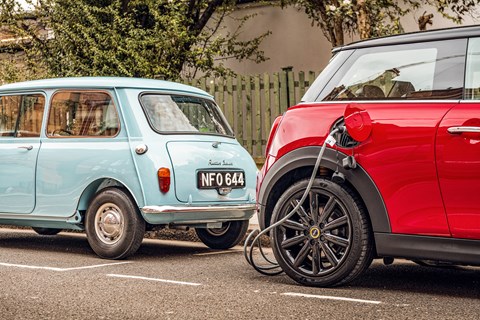
Zipping through the capital’s streets to our rendezvous point with the classic Mini earlier this morning, the Mini Electric certainly felt spirited. Like all electric cars, an addictive snap-hit of instant torque is ever-ready to squirt you away from traffic lights and roundabouts, and with 199lb ft available from its BMW i3S-sourced motor, Mini is marketing performance as a USP over other EV hatches.
While 0-62mph is a lively enough 7.3sec, it’s 0-30mph that’s the Mini Electric’s party trick. A touch of torque steer, the faintest chirrup of wheelspin and you’ve immediately exchanged here for there. Driven in a more orderly fashion, the throttle (okay, accelerator) map is cleverly, progressively calibrated and it’s easy to drive with precision. Energy regeneration under deceleration is nicely judged too, enabling you to drive one-pedal style, barely touching the brakes.
The powertrain feels such a natural fit for the Mini you wonder how it took so long for an EV version to become a reality. Then you remember recent advances in battery tech. The more primitive Mini E was leased in small numbers in a 2008 pilot scheme but it was heavy and compromised, losing its rear seats to make room for the batteries. This, the first productionised electric Mini, has funnelled its running gear into the existing Mini hatch architecture: the battery is a T-shape, arranged down the middle of the floorpan and under the rear seats, and the motor goes under the bonnet, utilising the engine bay’s existing mounting points.
Living with a Mini Electric: our long-term test
Helped by suspension architecture unchanged from regular pistons-‘n’-cylinders Mini hatches, the Electric handles like a modern Mini, too. Which means it’s capable of extravagant angles of lift-off oversteer, as scientific experiments on an empty roundabout on the way down to London the previous evening confirmed.
So, that’s the fun box ticked. What about character? One of the Mini Electric’s strengths – and a weakness to some – is that you can quickly forget it’s electric. It feels normal. If you enjoy driving a regular Mini, you’ll be right at home. If you don’t, this isn’t a paradigm shift to convert you.
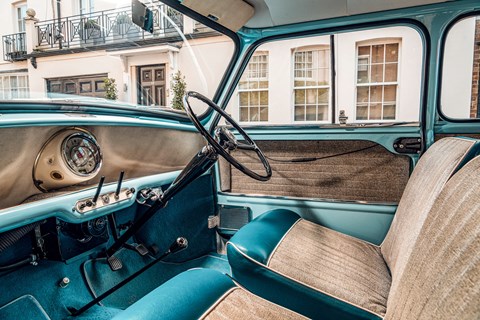
But any and every driver would be captivated by the Austin, which has charm to throw away. In Speedwell Blue, this one is concours-immaculate. Were it not for some gentle warping of the dash trim, it could have rolled out of Longbridge yesterday. Climbing in feels like a scene from Alice in Wonderland, as you crouch down to open a tiny door. Yet as soon as you’re inside, all they say about the Mini being tiny on the outside yet big on the inside makes sense. ‘Wizardry on Wheels’ was one of the original Mini ad lines, and there’s some kind of Harry Potter magic at play here to make the inside of this tiny car feel roomy. There are no side mirrors but there are so few obstructions to looking over your shoulder that you don’t miss them.
The trick is reversed in the Mini Electric, which sits a little cabin with thick pillars on top of a comparatively big body. At a glance it looks smaller from the outside than it really is, and feels more cramped than it should, accentuated by the dark trim in this test car. In the modern Mini there are cupholders and tiny, awkward door pockets; in the Austin, the famous optional wicker baskets designed to scoot under the rear seats, and gigantic door bins (made possible by using sliding windows instead of handier wind-down ones). Chief creator Alec Issigonis thoughtfully designed the doors to accommodate glass bottles of gin and tonic for picnics, so the story goes. Possibly considered less of an attribute by Euro NCAP today.
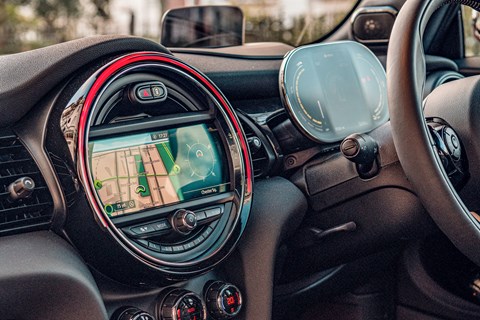
You sit on a squishy, headrest-less seat, reaching for the non-existent seatbelt in a reflex action before grasping a giant two-spoke steering wheel, which you look clean through at a surface more desk than dashboard. An over-sized Smiths speedo is the sole, central instrument, a cue that has become a modern-era Mini design hallmark. On the Electric, it now squeezes a touchscreen and a sat-nav unit within its radius.
The 850cc overhead-valve four starts sweetly at the first press of the floor-mounted starter button. Select first gear – found somewhere near your passenger’s right knee via the giant gearlever sprouting from the floor – and click the indicator on. There’s no instrument panel, so a green bulb flashes at the end of the chrome stalk, a delicious design detail like a cross between a Stratocaster tremolo arm and Sputnik.
And you make your way out onto the London streets, grinning at the joy of it all. Instantly, the Mini feels at home. This is the environment it was born for. No parking space is too small to swing into. If you take a wrong turn – as I do, quite frequently – the turning circle is so tiny you rarely need worry about a three-point turn. And even if you do, taxis and buses are ⊲ happy to wait for you – unheard of in London. People stop, stare and smile. There’s something about this car that puts everybody in a good mood. The Electric, meanwhile, blends into London traffic like a contrast-roofed chameleon. There are near-identical three-door Mini hatches everywhere, just as there must have been in the ’60s when everyone from Sellers to Cilla was haring around in Issigonis’s creation. That’s one of the Mini Electric’s strengths – it doesn’t look like an electric car for the sake of it. Only the blanked-off grille, yellow badging and absent tailpipe mark it out.
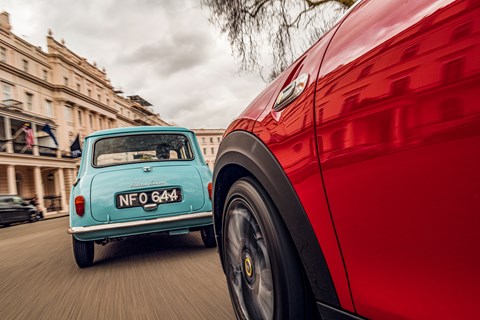
If one word describes how the original Mini drives, it’s ‘direct’. For every input, there’s an immediate response. You can see how the much-marketed ‘go-kart handling’ description came about. And you can also see how John Cooper was inspired to tune the Mini and take it racing. Soon, Mini Coopers were smoking their front tyres around South London’s Crystal Palace race circuit in the British Saloon Car Championship, crowd-pleasing Davids to battle Goliaths from Ford and Jaguar.
Transferring back to the Mini Electric takes some adjustment. I nearly put myself through the dashboard the first time I use the brakes, having got used to the classic’s leading-shoe drums. And a curving car-park ramp that was helter-skelter fun earlier in the Austin is now an ooh-that’s-a-bit-close, watch-the-alloys tip-toe in the Electric.
The new car, with performance prioritised over range, captures some of the same go-kart directness with a combination of rapid acceleration and exaggerated, ultra-quick power steering. Officially the Electric will manage 124-144 miles of average driving from a full charge, but that isn’t realistic. When we set off from the magazine’s Peterborough offices the previous evening, a 90-mile journey, the battery was 100 per cent full. But we had to stop for a top-up on the way, and then charged it to full overnight. That despite driving with the air-con turned down, and well below the speed limit. Most prospective owners will have a daily commute well within the car’s worst-case-scenario range. It’s a car for urban streets rather than A- and B-roads. But if that’s the case, the lively performance that sold you the Mini in the first place will rarely get used.
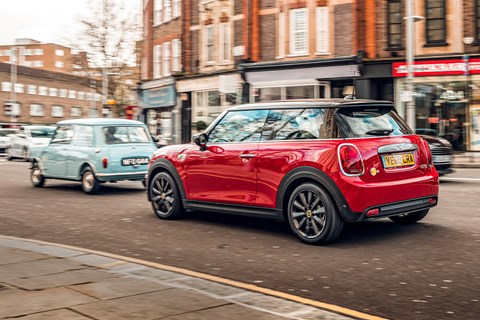
It was Time magazine that coined the term Swinging London with the coverline ‘London: the City that Swings’ (including a Mini in the cover illustration) in 1966, when the magazine you’re holding had only recently metamorphosed from Small Car and Mini Owner to CAR. Mary Quant’s mini skirt (reportedly named after the Mini) had helped build the Swinging London legend, from her boutique Bazaar on King’s Road. We make a pilgrimage, but today King’s Road is for the most part dominated by high-street chains; what once was Bazaar is now a chain coffee ‘n’ juice bar.
The cut of Quant’s clothes was simple and geometric, drawing parallels with the Mini’s form-meets-function styling. Issigonis bristled at being called a stylist, and his design was brutally functional, yet there’s alchemy in it: instantly recognisable from all angles, it wears a downturned mouth/grille that looks impudent rather than sad.
The modern Mini family is as much about form as function – more so, in fact. Wearing the original’s design cues has given it some of the same ‘it’-car status and cheeky spirit. But it’s more kitsch than cool, more Austin Powers than Austin Seven. (Its Union Jack motifs feel especially forced when Mini’s head office is in Munich.)
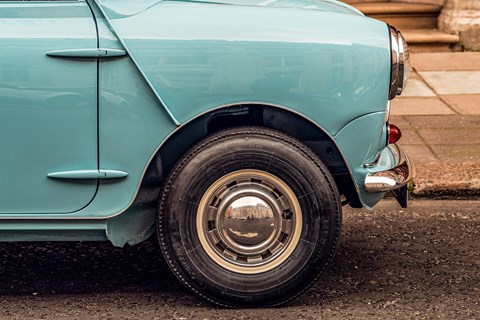
But let’s not pretend the original Mini was perfect, either. The same engineering complexity that made it a space-efficient marvel also made it costly to build and it had baked-in reliability issues. Other companies took its transverse packaging ideas and developed duller (but more dependable) cars that were better ownership propositions – including 2001’s first New Mini, a relatively conventional car in ’60s fancy dress. Famously, the original Mini was produced at a loss. At under £500 it was inexplicably priced as one of the cheapest cars on the market, despite hot-cakes demand. Not a mistake you could imagine present parent company BMW making. Today, both these cars are actually worth similar money. The Mini Electric starts at around £25k, factoring in the government’s electric car grant, and our top-spec test car exceeds £30k. But it’s the old one I’d yearn to put in my own garage.
There’s a lot to like about the Mini Electric. The EV running gear has been seamlessly integrated into the existing Mini hatch, and it’s more fun to drive than the competition. If you’re a Mini fan ready to go electric, it’s the car for you. But it doesn’t offer anything revolutionary and is not a demonstrably better, or more inventive, car than its rivals.
The new Mini as a species simply can’t be as inventively packaged as the original, of course. The need for more safety equipment, and the expectation of greater luxury and entertainment, mean a modern Mini must be fatter and harder to see out of by necessity. The Mini Electric is a stop-gap; a temporary best-fit EV using the existing car’s hard points. It’s the next electric Mini, due in 2022 and developed in conjunction with Chinese firm Great Wall, that will be a clean-sheet design.
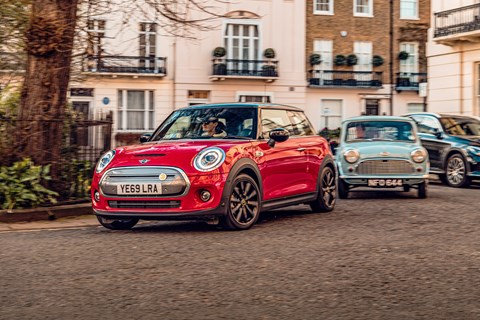
As I leave the Austin in West Kensington and head out of town in the Mini Electric, I hope the 2022 newcomer is technically progressive and well-executed. Even if it ends up looking less like a Mini, it could be truer to the spirit of the original’s engineering-driven inventor. The challenges of packaging pure EV powertrains have also opened up opportunities for lateral thinking rarely seen since the singular mind of Issigonis devised the original. Okay, it’s unlikely to feature 10-inch wheels, but wouldn’t it be great if the next electric Mini captured some of that brilliance?
Despite its inevitable Union Jack trim, it’ll be made in China’s Jiangsu Province, a long way from Swinging London. But in ethos as well as spirit, it could be a chance for a true successor to Issigonis’s flawed but miraculous creation. And you’d hope that it could manage to get from London to
Peterborough without stopping to charge the battery yet again.
Check out more CAR culture stories here